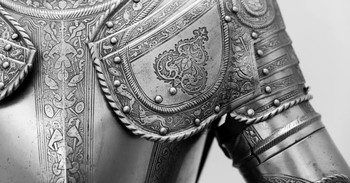What are the Nephilim?
The Nephilim are "mighty men" described in the Old Testament as incredibly large and physically strong. They are the children of the "sons of God" and the "daughters of man." Nephilim is translated as giants in some versions of the Hebrew Bible but left untranslated in others.
The Nephilim were on the earth in those days, and also afterward, when the sons of God came in to the daughters of man and they bore children to them. These were the mighty men who were of old, the men of renown. (Genesis 6:4)
There is almost always variance when discussing the Nephilim details in Christian circles today. Is there a correct answer to who precisely the Nephilim were? Scholars and theologians find this subject fascinating.
Nephilim: Fallen Angels or Giants?
The word Nephilim is found in the Bible two times. The first is in Genesis 6:1-6 and then again in Numbers 13:33. Scholars and commentators translate the word Nephilim as giants or fallen ones. Even among the most brilliant, there is debate on translating this term.
Several proposed interpretations of the term "Nephilim" are rooted in the assumption that it is derived from the Hebrew verbal root n-p-l (נ־פ־ל), meaning "fall." In 1871, Robert Baker Girdlestone suggested that the word originates from the hif'il causative stem, implying that the Nephilim could be understood as 'those that cause others to fall down.' Ronald Hendel, on the other hand, posits that it is a passive form, signifying 'ones who have fallen.' This grammatical structure is analogous to terms like paqid, denoting 'one who is appointed' (such as a deputy or overseer), and asir, signifying 'one who is bound' (like a prisoner).
The majority of ancient biblical translations interpret the term to mean "giants." While Aquila's translation from Hebrew to Greek has interpreted it to convey either "the fallen ones" or "the ones falling [upon their enemies]."
Genesis 6: Nephilim as Fallen Angels
Genesis 6:1-6 never states that the Nephilim were giants. Here, Scripture briefly mentions the Nephilim, describing them as the offspring of "the sons of God" and "the daughters of humans." These beings were on the earth in the days before the flood, described as "mighty men" and "men of renown."
"When man began to multiply on the face of the land and daughters were born to them, the sons of God saw that the daughters of man were attractive. And they took as their wives any they chose. Then the Lord said, “My Spirit shall not abide in man forever, for he is flesh: his days shall be 120 years.” The Nephilim were on the earth in those days, and also afterward, when the sons of God came in to the daughters of man and they bore children to them. These were the mighty men who were of old, the men of renown. The Lord saw that the wickedness of man was great in the earth, and that every intention of the thoughts of his heart was only evil continually. And the Lord regretted that he had made man on the earth, and it grieved him to his heart." - Genesis 6:1-6
Number 13: Nephilim as Giants
The verse that clues us into them being giants is Numbers 13:33, which states, "and there we saw the Nephilim (the sons of Anak), and we seemed to ourselves like grasshoppers, and so we seemed to them.” Here, Scripture indicates they were possibly giants, men much larger and stronger than usual.
According to the International Standard Bible Encyclopedia:
This word, translated "giants" in the King James Version, but retained in the Revised Version (British and American), is found in two passages of the Old Testament--one in Genesis 6:4, relating to the antediluvians; the other in Numbers 13:33, relating to the sons of Anak in Canaan. In the former place the Nephilim are not necessarily to be identified with the children said to be borne "the daughters of men" to "the sons of God" (Genesis 6:2-4); indeed, they seem to be distinguished from the latter as upon the earth before this unholy commingling took place. But it is not easy to be certain as to the interpretation of this strange passage. In the second case they clearly represent men of gigantic stature, in comparison with whom the Israelites felt as if they were "grasshopers." This agrees with Genesis 6:4, "the mighty men that were of old, the men of renow." Septuagint, therefore, was warranted in translating by gigantes.
No one really knows exactly who or what the Nephilim were; however, Scripture gives us clues about who the "sons of God" and the "daughters of men" were (Genesis 6:1-4).
Who Are the Nephilim? 4 Different Theories
For centuries, scholars from Judaism and Christianity have presented different views on who the Nephilim were.
1: The first view is that fallen angels had relations with the "daughters of men," which resulted in a part human, part supernatural being – the Nephilim.
2: The second position held by some is that demons or fallen angels possessed men and then had relations with the "daughters of men," resulting in the Nephilim.
3: A third position, called the Sethite View, is held by some scholars. The Sethite View defines the "sons of God" as the righteous line of Seth.
4: Lastly, a view held by the minority is the "sons of God" were simply fallen men.
Theory 1 - Nephilim as Offspring of Fallen Angels and Human Women: "Sons of God","Daughters of Men"
The view that has increased in favor today is that the Nephilim were offspring of fallen angels and human women has increased in favor today is the position that the "sons of God" were fallen angels who had relations with the "daughters of men" (Genesis 6:1-6), and as a result, the Nephilim were born. This is the most popular view in the Church today.
Support for the theory. A verse that supporters of this position turn to is Job 1:6: "Now there was a day when the sons of God came to present themselves before the Lord, and Satan also came among them."
In connection to this verse, Job 38:7 also tells us, "when the morning stars sang together and all the sons of God shouted for joy?"
These verses use the same term found in Genesis 6 refering to the Nephilim. Theologians historically have interpreted the "sons of God" as "angels," which fit right into the context of these verses. One main Scripture passage used to defend this view is Jude 1:6-7:
"And the angels who did not keep their proper domain, but left their own abode, he has reserved in everlasting chains under darkness for the judgment of the great day; as Sodom and Gomorrah, and the cities around them in a similar manner to these, having given themselves over to sexual immorality and gone after strange flesh, are set forth as an example, suffering the vengeance of eternal fire.”
The Jude 1:6-7 passage indicates some (fallen) angels went after strange flesh.
Opposition to the theory. One pushback for this position of Nephilim being the offspring of angels and humans is that angelic beings don't have the DNA to combine with humans. They are spiritual beings; therefore, it's not possible that they can produce offspring. Again, this assumes that angels can't have the same DNA as humans. Some would argue that it’s possible because we see two angels take the form of a human in Genesis 19:1-13. Who is to say they didn’t carry the full reproductive capabilities?
Theory 2: Nephilim were Descendants of Seth
The Sethite View that the Nephilim were from the lineage of Seth is growing rapidly within the Church and is possibly the most common view today among scholars.
Here, the "sons of God" are defined as the righteous line of Seth (Genesis 5) that disobeyed God and married women from the line of Cain. (Note: Some believe these women were not exclusive to Cain's family line). The women who married the line of Seth followed other gods and rejected full allegiance to God. The offspring, as a result, "fell away" and turned to the system of the world.
According to Jewish historical writings and literature as early as the first century, Jewish scholars have favored this view of the Nephilim being a fallen bloodline. St. Augustine and John Calvin are famous scholars and theologians who have held this position. Here, we assume that from Seth to Noah (Enosh, Kenan, Mahalalel, Jared, Enoch, Methuselah, Lamech), all the past members obeyed God to preserve a righteous lineage.
Theory 3: Nephilim were Human Children Posessed by Fallen Angels
When we discuss this third view that fallen angels possessed men, it may begin to connect with some of us because we can see the reality of demonic possession in today's world. From the movies in Hollywood to witchcraft around the globe, it's real.
The Heart of the Question: Are the "sons of God" (if human) able to become possessed?
The Answer: There is no evidence in the Bible to support this idea that God's children can become demon-possessed.
Theory 4: Nephilim were Offspring of Fallen Men
This last view claims that the “sons of God” were godly men who married ungodly women. Not from the line of Seth – just common men.
This union resulted in the Nephilim, a group of offspring that "fell away."
Debate with the theory. Again, we must go back to the fact that there is still debate as to what the term Nephilim means as it's related to the verb series "to fall" (Hebrew word “naphal”).
This view relies on the verb series "naphal," which means fallen or to fall.
Support for the theory. This position is consistent with Scripture, both pre-flood and post-flood.
Meaning before the flood, these offspring were "fallen men." After the flood (when God destroyed everyone but the family of Noah), these Nephilim are still showing up (Numbers 13:33). Therefore, the Nephilim are simply fallen men.
Why Are the Nephilim on Earth after the Flood?
This is a question asked by many people. If God flooded the earth, killing all mankind besides the family of Noah, how is it that Nephilim are still alive? Scholars have responded in a few different ways.
1. One answer to this question is: The Nephilim were giants, offspring of fallen angels (sons of God), and human women, so fallen angels continued reproducing with human women after the flood.
2. Another answer would be: The sons of God are fallen men. After the flood, different godly men had relations with different ungodly women and reproduced the Nephilim once again.
Extrabiblical Evidence of Nephilim in the Book of Enoch
The Book of Enoch describes angels marrying women on earth, and the offspring were a giant type of beings.
Enoch is not considered the inspired, authoritative word of God. Jews and early Christians held this book as a good read. Meaning it wasn't fully accurate but still held nuggets of truth.
Some say that it should be in the biblical canon because Enoch is quoted in Jude 1:14. But other writings are also quoted in Scripture that are clearly not the word of God (Acts 17:28; Titus 1:12).
Who Were Rephaim and Anakim and Are They Related?
We can't forget to consider the Rephaim when we speak of giants in the Bible and the Nephilim (Genesis 14:5).
One of the definitions of Rephaim, according to the Jews, is a people group of greater-than-average height and stature (Deuteronomy 2:20-21), also known as the Zamzummim. They were as tall as the Anakim, according to Scripture, which are other giants in the land.
Where did these giants come from? Some would argue that they can be traced back to Genesis 6.
How Tall Were the Nephilim?
The Bible does not provide specific details about the physical characteristics, including the height of the Nephilim. As a result, any information about their height is largely speculative and not based on explicit biblical descriptions.
Several biblical texts provide indirect clues about the height of the Nephilim. For instance, Numbers 13:33 mentions that the Israelite spies saw Nephilim in Canaan and felt like grasshoppers in comparison, implying considerable height. Additionally, Goliath, a giant described in 1 Samuel 17:4, was "six cubits and a span" tall, which is approximately 9 feet 9 inches. King Og of Bashan, another giant mentioned in Deuteronomy 3:11, had a bed about 13 feet long, suggesting he was close to this height.
Ancient texts outside the Bible, such as the apocryphal Book of Enoch, suggest even more extraordinary heights, sometimes describing giants as being up to 30 feet tall. However, these accounts are often considered legendary and are not supported by mainstream archaeology.
In modern times, there have been reports of unusually tall skeletal remains, particularly in North America, where skeletons measuring between 10 and 18 feet have been purportedly found. These findings are highly disputed and lack widespread academic acceptance due to the inconsistencies and lack of verifiable evidence.
Lastly, some scholars argue that the Nephilim's great height symbolizes their power and dominance rather than literal physical stature.
Was Goliath a Nephilim?
The biblical account of Goliath is found in 1 Samuel, chapter 17. Goliath is described as a giant and a champion of the Philistines, who were enemies of the Israelites.
"A champion named Goliath, who was from Gath, came out of the Philistine camp. His height was six cubits and a span. He had a bronze helmet on his head and wore a coat of scale armor of bronze weighing five thousand shekels; on his legs he wore bronze greaves, and a bronze javelin was slung on his back. His spear shaft was like a weaver’s rod, and its iron point weighed six hundred shekels. His shield bearer went ahead of him" (1 Samuel 17:4-7).
While Goliath was a formidable and exceptionally tall warrior, and 1 Samuel 17:4 mentions that he was "six cubits and a span," which is roughly 9.75 feet or 2.97 meters, the Bible does not indicate a measurement to determine Nephilim. The details given regarding both Goliath and the Nephilim do not create an explicit connection between the two in Scripture.
This article was adapted from "Who were the Nephilim?" on Elevating Your Life.
Edward Antonio is the Founder of Elevating Your Life and a student of theology and church history. He lives in Orange County, CA, and is part of Harvest Christian Fellowship. Find him on Instagram or answering Bible questions at https://elevatingyourlife.org/.
Photo Credit: GettyImages/bestdesigns



